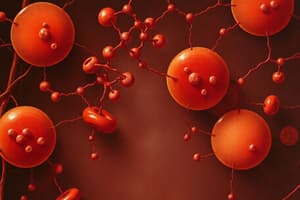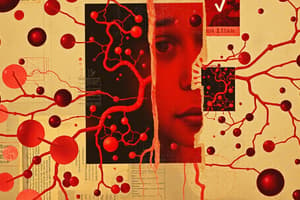Podcast
Questions and Answers
What is the approximate total concentration range of plasma proteins in g/dl?
What is the approximate total concentration range of plasma proteins in g/dl?
- 5.0 - 6.0
- 10.0 - 12.0
- 7.2 - 7.4 (correct)
- 2.5 - 3.5
Which plasma protein has the lowest molecular weight?
Which plasma protein has the lowest molecular weight?
- Globulin
- Fibrinogen
- Albumin (correct)
- Prothrombin
What is the primary site of synthesis for fibrinogen?
What is the primary site of synthesis for fibrinogen?
- Spleen
- Bone marrow
- Liver (correct)
- Lymph nodes
In what condition is the Albumin/Globulin Ratio (A/G ratio) likely to be decreased?
In what condition is the Albumin/Globulin Ratio (A/G ratio) likely to be decreased?
What percentage of globulins are produced in the liver?
What percentage of globulins are produced in the liver?
Flashcards
Albumin
Albumin
The most abundant protein in blood plasma; responsible for maintaining osmotic pressure and transporting various substances.
Globulins
Globulins
A group of proteins in blood plasma, further categorized into alpha, beta, and gamma globulins, each with specific functions.
Fibrinogen
Fibrinogen
A protein involved in blood clotting; converted into fibrin, which forms a mesh-like structure that traps platelets and blood cells to stop bleeding.
Prothrombin
Prothrombin
Signup and view all the flashcards
Albumin/Globulin Ratio (A/G Ratio)
Albumin/Globulin Ratio (A/G Ratio)
Signup and view all the flashcards
Study Notes
Plasma Proteins
- Plasma proteins are crucial components of blood plasma, with a concentration of 7.2-7.4 g/dL (grams per deciliter). A deciliter is 100 milliliters.
- Key types include albumin, globulins (α, β, γ), fibrinogen, and prothrombin.
- Albumin concentration: 3.5-5 g/dL
- Globulins (α, β, γ) concentration: variable, with specific ranges not given
- Fibrinogen concentration: ~0.4g/dl
- Prothrombin concentration: ~0.01 g/dl
- Molecular weights vary significantly across types, ranging from 69,000 Da for albumin to 340,000 Da for fibrinogen, reflecting diverse roles.
Protein Formation Sites
- Albumin, fibrinogen, and prothrombin primarily produced in the liver.
- Globulins: 50% from the liver (α, β) and 50% from plasma cells within the reticuloendothelial system (RES) (γ-globulins).
- RES cells are found throughout the body in the liver, spleen, lymph nodes, and bone marrow.
Albumin/Globulin Ratio (A/G)
- A normal A/G ratio is 1.2-1.6. This ratio is important for assessing health.
- A decreased A/G ratio may indicate:
- Liver diseases (cirrhosis, hepatitis)
- Kidney diseases (nephrosis)
- Infections
- This decrease is often due to reduced albumin production or increased albumin loss in urine. Increased gamma globulins often contribute to decreased ratio.
Molecular Size and Function
- Albumin's small molecular size allows for various functions within the blood, including transporting various substances.
Studying That Suits You
Use AI to generate personalized quizzes and flashcards to suit your learning preferences.




